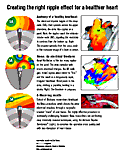


Cardiac research
A minimally invasive treatment for abnormal heart rhythm
|
Click here to download the information graphic that accompanies this story PDF FORMAT 48k |
See animated illustration below

Atrial fibrillation affects more than 2 million Americans.
![]()
A SAFER AND EASIER WAY to treat patients with the most common form of irregular heartbeat, atrial fibrillation, is being studied by researchers at the School of Medicine.
Investigators recently showed that applying the new technique, bipolar radiofrequency, in sheep yields similar results to a more invasive Maze procedure, the traditional curative treatment for the condition. The new procedure, using the Atricure Bipolar Handpiece™, is performed in less time and with less extensive surgery than before. More importantly, it can be done without using a heart-lung machine to stop the heart.
Sunil M. Prasad, MD, postdoctoral surgery fellow, presented the findings at the American College of Surgeons’ 2001 Clinical Congress in October. Ralph J. Damiano Jr., MD, professor of surgery and chief of cardiac surgery, led the study.
Atrial fibrillation affects more than 2 million Americans. The condition causes painful symptoms and may account for roughly 15 percent of all strokes in the United States. Medication can alleviate symptoms in some patients, but it cannot cure the problem.
Normally, electric signals trigger the synchronized contraction of muscles in the heart’s two upper chambers, the atria. During atrial fibrillation, a chaotic web of electric impulses spreads throughout the atria, causing the chambers to quiver rather than contract in unison.
| The heart's electrical system in action | |
 |
 |
| Healthy heartbeat — The electrical impulse begins at the sinus node (red), then spreads across the upper chambers, the atria, like ripples on a pond. | Electrical firestorm — Atrial fibrillation is like too many ripples on the pond. The atria convulse with erratic electrical charges. |
In 1985, researchers at the School of Medicine developed
a surgical cure called the Maze procedure to control these erratic impulses.
In the procedure, surgeons make small, strategically placed incisions
in the atria. The slits generate scar tissue that serves as a barrier,
trapping abnormal electric signals in a "maze." Only one path
remains intact, guiding impulses to their correct destination.
With a success rate of more than 90 percent, the Maze procedure revolutionized
the treatment of atrial fibrillation. However, it is technically difficult
and therefore is not performed frequently. Because surgeons must temporarily
stop the heart in order to make the incisions, not all patients are healthy
enough to endure the operation.
Now researchers have developed an alternative: bipolar radiofrequency. The method uses two electrodes that pass a current through a section of heart tissue. The current heats and kills a band of clamped tissue. Like Maze procedure incisions, radiofrequency energy causes scar tissue that blocks the abnormal impulses responsible for atrial fibrillation.
The team tested the procedure on five sheep at four of the standard Maze incision locations. Each lesion took nine seconds to complete, as compared with Maze incisions, which take five to 10 minutes to create.
Preliminary findings suggest that the procedure is safe
to do in human patients. Damiano and his colleagues will be the lead investigative
site of a multicenter clinical trial of the new technique.![]()
![]()
